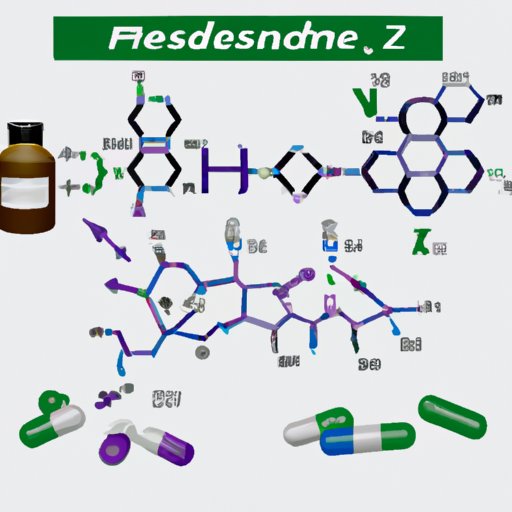Introduction
Pseudoephedrine is an over-the-counter drug commonly used to treat nasal congestion caused by allergies or the common cold. It belongs to the class of drugs known as decongestants, which work by constricting the blood vessels in the nose to reduce swelling and mucus production. Pseudoephedrine is available in both tablet form and liquid form and is often combined with other medications, such as ibuprofen and acetaminophen, to provide additional relief.
Exploring the Science Behind Pseudoephedrine: How Does it Work?
To understand how pseudoephedrine works, it’s important to explore the science behind the drug. Pseudoephedrine has several components that contribute to its effectiveness, including its mechanism of action, pharmacokinetics, and physiological effects.
Understanding the Mechanism of Action of Pseudoephedrine
The mechanism of action of pseudoephedrine is fairly simple. The drug works by stimulating alpha-adrenergic receptors in the lining of the nasal passages, which causes constriction of the blood vessels in the area. This constriction reduces swelling and mucus production, resulting in relief from the symptoms of congestion.
A Closer Look at the Pharmacokinetics of Pseudoephedrine
Pseudoephedrine is quickly absorbed into the bloodstream after ingestion, reaching peak levels within 1-2 hours. It is metabolized in the liver and eliminated from the body primarily through urine. The half-life of pseudoephedrine is approximately 6 hours, meaning that it takes about 6 hours for the drug to be reduced to half of its original concentration in the body.
Decoding the Physiological Effects of Pseudoephedrine
When taken as directed, pseudoephedrine produces several physiological effects. In addition to reducing nasal congestion, the drug can also reduce the size of swollen lymph nodes due to allergies, improve breathing, and reduce coughing. It may also have a stimulant effect on some people, resulting in increased alertness and energy.
The Pros and Cons of Taking Pseudoephedrine
Like any medication, there are both benefits and risks associated with taking pseudoephedrine. On the plus side, the drug is generally safe and effective when taken as directed. It’s also easy to find and relatively inexpensive. However, there are some potential side effects to consider, including dizziness, dry mouth, headache, and insomnia.

Examining the Role of Pseudoephedrine in Allergy Relief
In addition to treating the symptoms of congestion, pseudoephedrine can also be used to treat certain types of allergies. By constricting the blood vessels in the nasal passages, pseudoephedrine can reduce inflammation and help relieve the symptoms of allergic rhinitis, such as sneezing and runny nose.

Investigating the Molecular Structure of Pseudoephedrine to Understand its Function
The molecular structure of pseudoephedrine is composed of two main components: a phenylethylamine moiety and an ethanolamine moiety. These components interact with each other to produce the drug’s desired effects, such as constriction of the blood vessels in the nasal passages and reduction of swelling and mucus production.
Conclusion
In conclusion, pseudoephedrine is a decongestant commonly used to treat nasal congestion caused by allergies or the common cold. To understand how pseudoephedrine works, it’s important to explore the science behind the drug, including its mechanism of action, pharmacokinetics, and physiological effects. Pseudoephedrine can also be used to treat certain types of allergies and is generally safe and effective when taken as directed. However, there are some potential side effects to consider, so it’s important to discuss any concerns with a doctor before taking the drug.
Summary of Pseudoephedrine
Pseudoephedrine is an over-the-counter drug commonly used to treat nasal congestion caused by allergies or the common cold. It works by stimulating alpha-adrenergic receptors in the lining of the nasal passages, causing constriction of the blood vessels in the area. Pseudoephedrine is quickly absorbed into the bloodstream after ingestion, reaching peak levels within 1-2 hours. It can also be used to treat certain types of allergies and is generally safe and effective when taken as directed.
Benefits and Risks of Taking Pseudoephedrine
The benefits of taking pseudoephedrine include relief from the symptoms of congestion, improved breathing, and reduced coughing. Potential side effects include dizziness, dry mouth, headache, and insomnia. It’s important to discuss any concerns with a doctor before taking the drug.
(Note: Is this article not meeting your expectations? Do you have knowledge or insights to share? Unlock new opportunities and expand your reach by joining our authors team. Click Registration to join us and share your expertise with our readers.)
